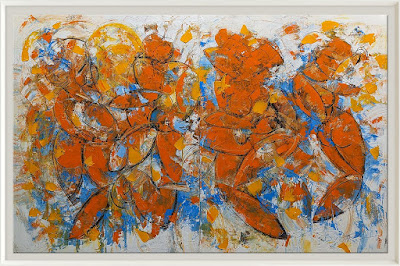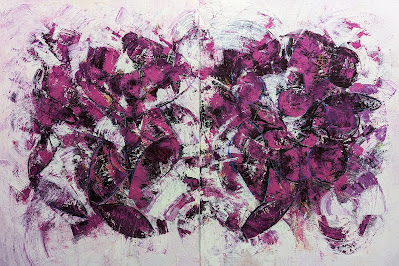Reconnecting with the past
 |
| Painting by Krish Iyer |
The large format paintings in ‘Wilderness Escapades’ reference these sculptures and the underlying premises, to create a spatial interplay of light, colour and texture to suggest the form, postures and gestures of the stone statues in a quasi-representational style. The artist’s interpretations are moored around the historicity of the temples, their geography - located as it is amidst forested land and wilderness, with their beauty and splendor remaining undiscovered for centuries. And, their subsequent desecration by invaders, all of which weave an intriguing narrative of mystery and mystique, of magnificence and ruin, of worldwide fame and remoteness. The art and architecture of the Khajuraho temples combined with their religious, cultural and historical significance form an intrinsic part of their allure. Numerous stories, philosophies and other intangibles lie beneath the surface of the stones, creating sagas of seduction, lure and enigma.
Krish’s canvases explore these histories, the abstracted notions of human potential, philosophies of living, corporeality of the flesh and temporality of life. The visual semantics are anchored in formal aesthetics, with defined line drawings marking the canvas, while the abstract expressionist approach at later stages lends critical layers of texture, and simultaneously recontextualizes historical content.
 |
| Painting by Krish Iyer |
The tactile surface of the works emerges from heavy textures, layers of dripping paint, and several applications of thick acrylic paint using the impasto technique. The palette knife and other tools transform the canvas, to add depth and dimension, to strip off extraneity and to emphasize salient features of the physical form. Transcendence, man and nature (re)union, the cycle of life and rebirth, and joy of living are some of the key principles that are depicted at Khajuraho temples, and it is these that Krish seeks and attempts to portray in his works. The deliberate obliteration of details in the figures, and the structurally accurate forms that replicate their defiled state, are incandescent with the ironies of transience – both natural and as outcomes of anarchist interventions.
Despite the precision of line drawings that form the basis of the works, Iyer’s methodology is essentially non-mimetic. The gradual yet decidedly gestural transformation of the painting surface as a pictorial array of subconscious thoughts and patterns rescinds identifiable characteristics and accentuates the metaphorical import.
After a successful career in commercial art, Krish has returned to painting with this solo exhibition - to pursue subjects and themes that resonate with him. A chance encounter with the Khajuraho temples almost three decades ago, stayed with him through the years and a strange yearning drew him back to them recently. This series originated from the revisit, marked by an innate desire to reconnect with nature, and to allow subconscious thoughts and emotions to surface and transform on canvas. With this exhibition, Krish attempts to break the invisible shackles that have contained his creativity all these years and to realize his inner potential.
Nalini S Malaviya
Art Critic
March, 2023
To contribute articles, please get in touch at artsceneinfo@gmail.com
Also read,




















